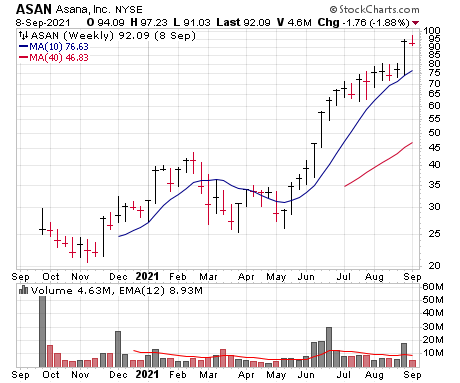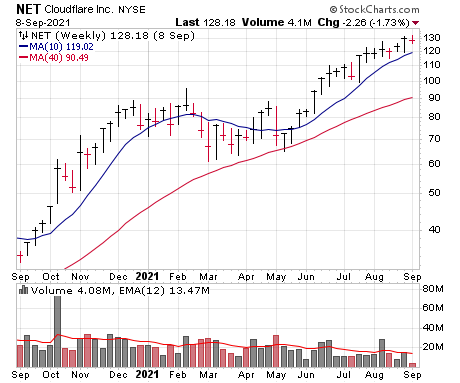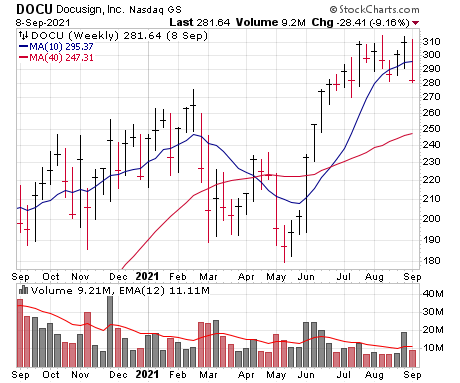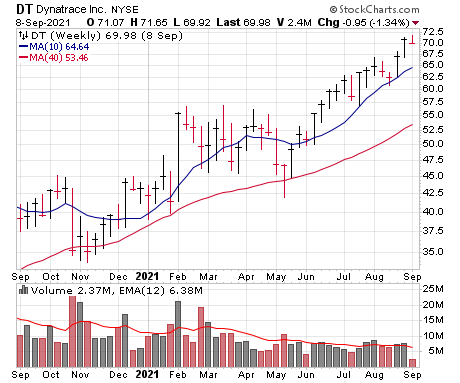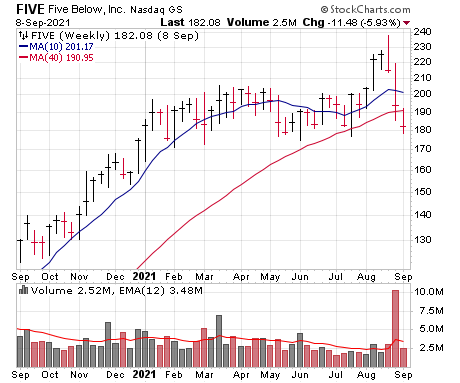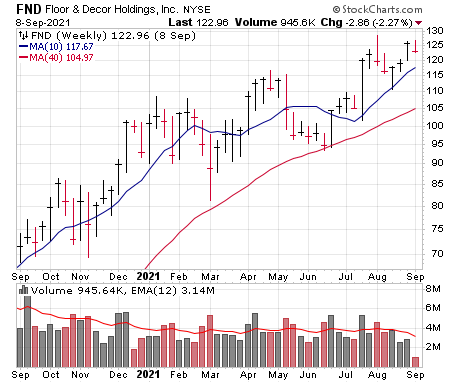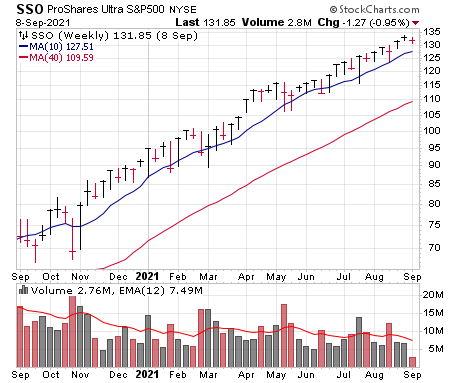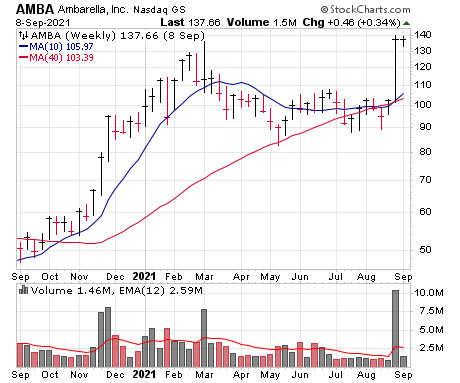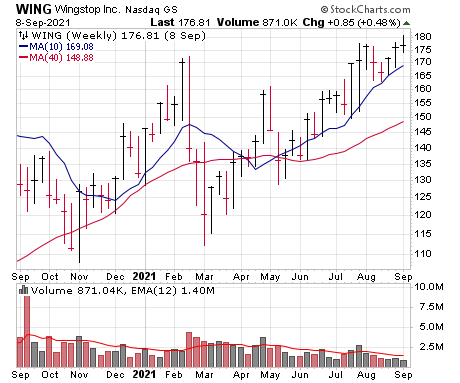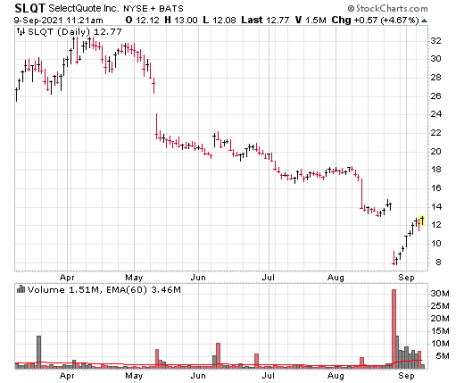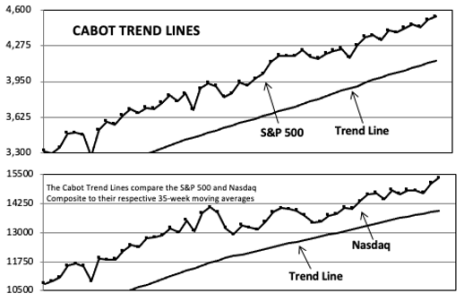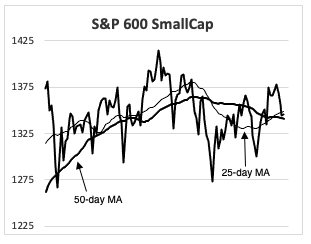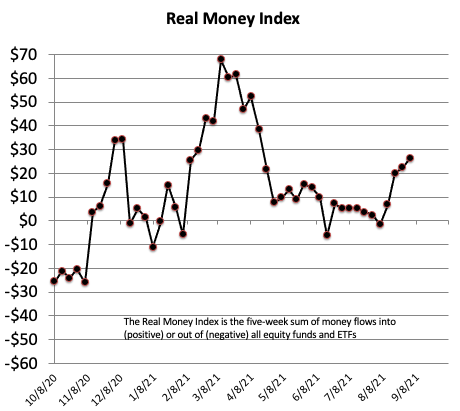Growth stocks have gotten off a bit of a sour start in September, with a couple of leaders cracking near-term support and a few collapsing completely. That tells us the tricky environment remains in effect ... and yet, we don’t think the action is bad at all. Indeed, most growth stocks remain in good shape, and frankly a further pullback should offer up some high-odds entry points.
Tonight, though, we’re standing pat with our 32% cash position after selling one stock earlier this week.
Cabot Growth Investor 1480
[premium_html_toc post_id="237259"]
The Roller Coaster Ride Continues
Back in my younger days I was a big fan of roller coasters—not that it was a regular thing, but whether on vacation to Disney or Universal Studios or just a day trip to a local theme park, I’d always hit up a couple of the popular ones. They were fun … but after two or three goes at it, that was enough excitement for me.
A stock market roller coaster is obviously less fun from the get-go, so you can imagine how investors are feeling these days—after a pretty solid August, September is off to a rough start for growth, with some leaders cracking near-term support and a few blowing up altogether.
Indeed, growth indexes and funds (think IWO and ARKK), which had shown a minor change in character of late, have been rejected once again as they approached resistance. In other words, the tricky, challenging and choppy environment is still with us, which continues to argue for a selective, go-slow, buy-on-weakness-type of approach. In the Model Portfolio, we’re up to around one-third in cash after having to dump one stock this week.
With all of that said, we don’t want to sound too negative. After all, a lot of growth stocks (finally) broke out in July and August, and while there was plenty of ups and downs, a bunch did show great upside follow-through after getting going, so some type of rockiness was half-expected. And now, we’re on the hunt for what we call early-stage pullback opportunities: Growth stocks that decisively lift from multi-month bases usually present good risk/reward situations on their first meaningful pullback—so if we see a few names dip reasonably for another few sessions, we expect to be putting more money to work.
As always, though, we’ll just take it as it comes and stay in gear with the evidence—if things go into the soup again during a traditional September/October correction, we’ll be pruning our weakest names and holding more cash. Right now, though, we’re optimistic that we own a handful of relatively fresh leaders, and until proven otherwise, think growth stocks remain in the process of slowly, jaggedly emerging from their post-February consolidation.
What To Do Now
Hold your strong stocks, sell your weak ones and keep your watch list up to date should some enticing entry points emerge. In the Model Portfolio, we dumped Five Below (FIVE) earlier this week due to its abnormal selloff, and we also placed DocuSign (DOCU) on Hold. That said, our other names still act well, and we’re aiming to putting money to work on normal weakness. Tonight, though, we’ll sit tight with around 32% in cash.
Model Portfolio Update
The chop has returned post-Labor Day, with growth stocks pulling in and a few stocks falling beneath key support. To be fair, the action isn’t wholly unexpected—while few stocks were racing to the moon, many did have good runs for a few weeks, so a pullback (especially in the choppy environment of 2021) isn’t shocking.
As always, we’re managing things on a stock-by-stock basis—every week or two seems to bring a new pothole before money rotates somewhere else, which has allowed us to hold onto most stocks despite their wild action, but on Tuesday morning we had to let one go: Five Below’s (FIVE) action was clearly abnormal during the past week, and the dip below the 200-day line was too much for us to ignore.
That said, we think any further weakness in the market could bring some good opportunities in a bit—after finally seeing more upside breakouts and follow-on rallies in August, a lot of stocks we’re watching should be high-odds buys on dips into support. Tonight, we’ll stand pat with our 32% in cash, but we’re keeping our watch list up to date and could make a move if we see another few days of consolidation.
Current Recommendations
| Stock | No. of Shares | Portfolio Weightings | Price Bought | Date Bought | Price on 9/9/21 | Profit | Rating |
| Asana (ASAN) | 1,354 | 6% | 73 | 7/22/21 | 97 | 34% | Buy a Half |
| Cloudflare (NET) | 1,790 | 11% | 113 | 8/27/21 | 128 | 13% | Buy |
| Devon Energy (DVN) | 7,240 | 10% | 28 | 5/7/21 | 28 | 1% | Hold |
| DocuSign (DOCU) | 682 | 9% | 291 | 6/25/21 | 281 | -3% | Hold |
| Dynatrace (DT) | 3,114 | 10% | 65 | 8/6/21 | 71 | 8% | Buy |
| Floor & Décor (FND) | 1,845 | 11% | 111 | 4/9/21 | 125 | 12% | Buy |
| ProShares Ultra S&P 500 (SSO) | 1,741 | 11% | 60 | 5/29/20 | 131 | 118% | Buy |
| CASH | 668,627 | 32% |
Asana (ASAN)—ASAN was acting sloppy for a few weeks, but a very bullish Q2 report has caused a fresh rush of buying. The big story of the report wasn’t so much the numbers (though they were excellent—revenue growth accelerated again to 72%) but the fact that, after a long time of being deployed in a department here or here, Asana’s work management platform is now seeing widespread adoption among big enterprises. On the conference call, the top brass talked about a few specific deployments and said that revenue received from its largest customers (those spending at least $50,000 annually with Asana) rose a whopping 45% from a year ago—meaning these whales are ordering more after (usually smaller) initial test runs, including some that have 25,000 employees using the platform. The stock has zoomed higher on the news and has actually extended those gains this week despite the wobbles in growth stocks. We’re aiming to average up (fill out our stake by purchasing another half-sized position), but given that ASAN is extended and the sell-strength environment, we’ll hold off a bit and see if shares can set up a better risk-reward entry point. We will stay on Buy a Half, though again, aiming for dips is advised. BUY A HALF
Cloudflare (NET)—Cloudflare remains in a firm uptrend, with support again showing up near the 25-day line last week, leading to a jump to new highs. All signs continue to point toward the company being the next big networking winner, replacing the firms that produced all the hardware boxes (think Juniper, Riverbed and the like) as well as some older cybersecurity players as well with its own solution that’s built from the ground up for the cloud era. The big stat that speaks of the potential here is that just 19% of the Fortune 1,000 are paying customers—some of the biggest might set up their own operations, of course, but there’s no reason that figure can’t double or triple, while current customers expand their usage (same-customer revenue growth was 25% in Q2). Back to the stock, it has had a big run for the past few months, so some sort of air pocket wouldn’t shock us in the near term, but until proven otherwise, the trend is certainly up. BUY
Devon Energy (DVN)—Even though oil prices are hanging around the $70 level, DVN continues to get tossed around by daily movements in the commodity as well as market factors (cyclical stocks in or out of favor, etc.). Still, to this point, nothing has really changed with the story (cash flow and dividends should still be monstrous with energy prices at these levels), the chart (shares are still within the confines of a 14-week consolidation) or our thoughts—as long as the stock is range bound, we’re happy to hold on, as it’s likely this rest is the pause that refreshes the overall uptrend. That said, unless you want to trade in and out of the stock every few days, we’re comfortable waiting for DVN to show decisive strength before restoring our Buy rating, while using a mental stop in the 25 area (near the lows of July and August) in case something goes wrong. Hold for now. HOLD
DocuSign (DOCU)—DOCU has taken a turn for the worse, experiencing a short-term breakdown that prompted us to place the stock on Hold. Fundamentally, nothing is wrong here—once again in Q2, not only did sales (up 50%) and earnings (up 176%) top expectations, but the sub-metrics impressed, with billings lifting 47%, same-customer revenue growth coming in at 24% and total customers improving 17% just in the first half of the fiscal year. The question here is whether growth will decelerate in a big way after the surge of the past year; analysts hiked their 2022 estimates modestly after the recent report and are looking for “only” 27% earnings growth (down from 94% this year). That could be a reason for the breakout failure this week, but we think it’s probably more simple than that—DOCU has had a big run from its lows in May, and with growth stocks selling off some, the stock may need to rest. The bigger issue to us isn’t the past few days, but the prior two months—shares have now done nothing since the end of June and are showing us a modest loss. We’re not panicking here, but Hold is definitely the right rating, and if all’s well we’d expect DOCU to find support above the 265 to 270 area. HOLD
Dynatrace (DT)—DT acts great, though like many names that bounced nicely last month, some retrenchment wouldn’t surprise as its 50-day line (now near 64) moves steadily higher. The entire application performance management and infrastructure monitoring space has long been one of our favorite themes, and Dynatrace is clearly a leader (Datadog (DDOG) is another new-age player in the space, and we’re pleased to see its stock acting well, too). We keep going back to the passage we shared in the last issue, with management effectively saying that competition for massive multi-cloud deployments has actually gone down in recent quarters, thanks in part to the fact that Dynatrace’s platform is perfectly suited for huge companies that are transitioning massive amount of apps, data and infrastructure. Of course, things can always change, but listening to the top brass (and reading through some analyst reports), it’s not hard to pick up on the vibe that they see years of 25% to 30% growth coming down the pike. Back to the stock, while it has had a nice run since May along with some leading growth names, remember that DT made no progress for the 11 months before that. Translation: Odds favor the stock is still early in its overall run. We’ll stay on Buy, but again, buying on dips is preferred. BUY
Five Below (FIVE)—If you’ve read us for any length of time, you know that we like to think in terms of odds—we always want to try to be with the odds rather than against them, but that doesn’t mean the unusual doesn’t happen from time to time. FIVE is an unfortunate example, as its beautiful breakout and strong upside follow-through from a multi-month base early last month completely fell apart after fears of higher costs (first on Dollar General’s quarterly report, then after Five Below’s own report last week) ripped through the sector. To be fair, those fears do seem overblown, but we’re wondering if the market is sniffing out something else—FIVE’s massive-volume break (biggest weekly volume since June 2020) not only crushed the recent breakout but has landed the stock below its 200-day line. Long-term, we could revisit the stock again when things shape up, but given the damage, that probably won’t be for a while. We sold our position on a special bulletin Tuesday morning. SOLD
Floor & Décor (FND)—FND broke out from a four-month base in April, only to get yanked down by the entire market soon after. Then, after basing out for another two-plus-months, shares lifted to new highs in July … only to be rejected after earnings and fears of a housing slowdown picked up. Now the question is whether the third time will be the charm, as shares have formed a shallower, tighter rest period during the past few weeks, with an encouraging (albeit low volume) rally during the past couple of weeks. As always, we’ll just play it by the book—if the stock fails badly from here and breaks support in the mid-100s then all bets are off, but right now, the path of least resistance remains up and the major cookie-cutter story is in great shape. If you own some, hold on, and if not, we’re OK grabbing a position here. BUY
ProShares Ultra S&P 500 Fund (SSO)—The S&P 500 has pulled back four days in a row, but at least to this point, the dip has been normal and (like many individual stocks) comes after a solid run. Interestingly, as SSO (which moves twice the daily move of the S&P 500 on a daily basis) has risen, it’s naturally become our biggest holding by a smidge—no cause for concern, but that does raise the likelihood that, when the S&P 500 finally cracks (a dip from here into the low 120s might do it), we could take partial profits. Still, at this point, the buyers are clearly in control, with the leveraged long fund gliding above its 10-week moving average. If you want in, we’re OK starting a position around here. BUY
Watch List
- Ambarella (AMBA 146): AMBA is a volatile chip stock, but years of R&D seem to be paying off. See more below.
- Dexcom (DXCM 553): DXCM has stretched higher after a brief consolation. If the market does pull in some, we think a corresponding dip in the stock could be buyable.
- DraftKings (DKNG 64): DKNG isn’t quite set up yet, but the story is as good as ever and the stock looks to have gradually changed character in recent weeks. See more below.
- LightSpeed (LSPD 124): LSPD remains one of our top ideas that we don’t own—it smells like a follow-on play to Shopify of sorts. Interestingly, while many related firms have broken down this week (partly on news Amazon was introducing its own point-of-sale system), LSPD has remained extremely strong.
- Wingstop (WING 181): Having been kicked out of FIVE, we’re open to adding another cookie-cutter name, and Wingstop is one of the best out there. See more below.
- ZoomInfo (ZI 64): ZI remains our favorite software story that we don’t own, with a durable long-term growth story and a fresh, early-stage breakout.
Other Stocks of Interest
Ambarella (AMBA 146)—Ambarella is a relative small fry in the chip space, with a market cap of around $5 billion and an on-again, off-again history. However, the company has built on its video processing roots in recent years and appears to have something special: Over four years, the company invested north of $550 million to develop a unique, artificial intelligence architecture that’s optimized for endpoint applications; combined with its video processors, it results in a computer vision chip that allows machines to visually perceive and “make” decisions, which in turn boosts automation, giving it huge potential in the IoT and auto market. Indeed, Ambarella has long been a leader in security cameras (made up 60% of last year’s revenue), and most of them are designed for human viewing; as upgrades occur among the 900 million security cameras out there, demand for the firm’s chips will soar. But autos should be an even larger prize here, as the continual increase in the number of cameras per car (average now of just 1.5 cameras, but many newer ones have five or more) plays into the firm’s hands. And then there are commercial fleets, which often adopt new products quicker than others. To be clear, this newer computer vision business is still small (25% of total revenue this year) but is expected to triple this year. Indeed, Q2 showed sequential increases in both automotive and security revenue, and the top brass dramatically boosted the outlook for Q3 as well, which caused a change in perception for the stock—AMBA exploded out of a deep base last week after the report on volume that was 18 times average! Granted, this isn’t the most liquid name, but it seems like a blastoff to us, and the bullish earnings estimates (earnings up 345% this year off a low base, and another 27% in 2022, which is likely conservative) have us intrigued.
DraftKings (DKNG 64)—DraftKings has always been something of an outlier when it comes to the market—on one hand, it’s a wild stock, with corrections of 40%-plus (three during the past 15 months!) a regular feature. But on the other hand, it’s the blue-chip in the online sports betting, iGaming (online casino) and daily fantasy sports sector, has quickly attracted a host of mutual funds (732 now own shares, up from 294 nine months ago!) and its prospects are as bright as ever, all of which has us keeping an eye on the stock. Fundamentally, the main story here hasn’t changed, though the numbers continue to improve; in Q2, total monthly paying customers lifted 280%, while revenue per customer grew 27%, and this happened despite the reopening of most casinos across the country, too. (Indeed, New Jersey’s iGaming revenue grew 30%-ish in May and June from a year ago despite casinos opening their doors; DraftKings Jersey growth was more than double that.) Plus, nearly every week brings an expansion of some sort—just since the start of August, the company acquired Golden Nugget’s iGaming operations (a market leader in the segment), inked an exclusive fantasy and online sports betting deal with the Baltimore Ravens, launched its daily fantasy offering in Arizona (the 44th state up and running) and launched sports betting in Wyoming. Of course, any near-term data points on NFL betting (season starts tonight!) could move the stock around, but there’s little doubt the big-picture outlook continues to improve. As for the stock, DKNG isn’t set up yet, but after such a deep retreat (46%), it’s definitely acting better, with some solid accumulation during the past six weeks and more controlled trading, too. There’s still a lot of overhead to chew through, but a couple more weeks of constructive action would be tempting.
Wingstop (WING 181)—Wingstop is in a similar category as DraftKings in the sense that it’s a great long-term growth story, but timing is everything, and the stock has spent the past year doing a lot of bobbing and weaving—but now is looking ready to continue its major uptrend. The company’s story is as simple as can be—wings in a bunch of different flavors, along with fries, shakes and the like—but as is the case with a handful of top operators, management has done an outstanding job of thriving since the virus appeared. Wingstop was always heavier on takeout than the average restaurant, but in Q2, it got a whopping 65% of its orders online and has a goal to be fully digital on that front down the road … something that is dramatically boosting sales per location. Indeed, consider that of all locations the company opened in 2019, the average restaurant cranked out $900,000 of sales in their first year; today, that figure is up to $1.2 million! (Initial first-year investment cost has remained around $400,000 during that time.) The fear here is that growth will slow compared to last year, when business exploded as the pandemic took hold, but like many pandemic winners, it’s turning out demand is still rising—same-store sales in Q2 grew 2.1%, but that was on top of a 30% gain last year, and despite a 125% increase in wing prices (!), earnings and cash flow still lifted at double-digit rates. (The firm recently launched an all-digital offering called Thighstop that could allow it to use more meat and boost margins.) Of course, big picture, unit growth will be a growth driver, with the restaurant count rising 12% this year and the top brass seeing the opportunity for 6,000 stores globally, up from about 1,600 today. As mentioned above, the stock has been up and down for the past year, but could be changing character, spending the past five weeks in a calm, proper range. We’d like to see a bit more strength, but WING is back on our watch list.
Two Ways to Diversify Your Portfolio
You won’t see us writing a lot about diversification, mainly because … we don’t believe in it that much. Our Model Portfolio’s “standard” position size is 10% in each stock, so ideally, we’d be fully in 10 strong growth stocks, which certainly isn’t what the pundits advise. That concentration does lead to some tedious periods, no doubt, but homing in on a couple of upside outliers (see below) is one of the keys to making good money.
However, after fielding a bunch of questions during the past two weeks, I did want to touch on two diversification principles that are important even if you do run a concentrated portfolio like us. The first is the most obvious—you want to make sure you never get too heavy in a single sector. One guideline we heard years ago that’s always made sense to us is, in a perfect world, you would own the top leader in the handful of leading industries in the market at that time. Today that might mean the best retail cookie-cutter story, the best cloud software name, the best chip stock, the best biotech leader, maybe the top cyclical stock (if it had a good story, etc.) and so on.
Of course, all these growth stocks swim together to some extent, but the point is we try not to own more than two names in a similar group—instead of going after a third, say, cloud software name, you’re probably better off finding the top name in a separate area.
The other diversification technique is less defined, but we pay a lot of attention to it when selecting stocks for the Model Portfolio. It’s the concept of liquid leaders (well-traded and well-sponsored stocks with just about all of the metrics we look for) and glamour names, which tend to have amazing stories and fast-moving stocks, but often lack a couple of key traits and are much harder to hold onto.
Don’t get us wrong: Both kinds of stocks can work well (we’ve had many big winners from each category), but we often relate it to a dinner—the main course should be the liquid, emerging blue-chip-type of names that you have a better shot of stomaching, while the dessert is often a couple of glamour bottle rockets that often fail but, when they hit, they can hit extremely big.
Of course, diversification speeches aren’t super exciting, but especially in a challenging growth stock year like 2021, making sure you’re following a couple of key principles and not throwing caution to the wind can help you stay in the game.
It’s (Still) a Game of Outliers
This year has generally been characterized by sharp but relatively brief moves—a swing trader’s delight of sorts, with a lot of stocks whipping around 10% to 20% in a few weeks and then reversing the move. That’s the main reason we’ve been going slow.
But remember that the market’s music is always changing; the longer this action goes on, the closer we’re getting to a more trending environment. Plus, even in the chop-fest, it’s important to remember that over time it’s the outliers (both good and bad) that really make the difference in your portfolio.
Said another way: You still want to give yourself a chance to make good money on the upside, though taking partial profits on the way up makes more sense in this environment. And, on the downside, you should be taking pains to avoid any big losers.
One way to do that is to start with smaller positions; whether it’s half-sized (like we’ve been doing a bunch) or something similar, starting small and adding only if the stock (and market) stay healthy can keep the duds minimal. But whatever your position size, it’s important not to just hold and hope. SelectQuote (SLQT) was a name we thought had great potential and certainly looked “oversold” in May when we dumped it—but then it fell another 70%!
The bottom line here is that, while the year has been a grind and very choppy so far for most individual stocks, it’s still important to think in terms of outliers—avoiding the bad ones keeps you in the game, and catching a couple of shooting stars can make all the difference to your portfolio for the year.
Cabot Market Timing Indicators
For the most part, the story remains the same: The major bull market is definitely intact, but there are plenty of crosscurrents and the recent push higher has begun to get investors more excited. We’re more bullish than not, but timing and stock selection are key.
Cabot Trend Lines: Bullish
The decisive push higher by the big-cap indexes has kept our Cabot Trend Lines firmly in bullish territory, with the S&P 500 (by 9%) and Nasdaq (by 10%) coming into this week firmly north of their respective 35-week moving averages. This indicator doesn’t move much, but that’s the point, and the 14-month old green light remains in great shape.
Cabot Tides: Neutral
Our Cabot Tides remain a split decision, with bigger-cap major indexes (S&P 500, Nasdaq) looking good, while broad market indexes (like the S&P 600 SmallCap, shown here) still range bound—though, to be fair, we have seen some improvement during the past couple of weeks. We’re keying more off the action of individual stocks right now due to the divergences and crosscurrents, but a decisive intermediate-term green light would be a plus.
Cabot Real Money Index: Neutral
After a few months of waning enthusiasm, our Real Money Index is starting to pick up on growing optimism—money flows into equity ETFs and mutual funds have increased markedly during the past three weeks. Looking at the five-week sum, it’s still in neutral territory, but another week or two of big inflows could trigger a near-term yellow light.
Charts courtesy of StockCharts.com
The next Cabot Growth Investor issue will be published on September 23, 2021.
Cabot Wealth Network
Publishing independent investment advice since 1970.
President & CEO: Ed Coburn
Chief Investment Strategist: Timothy Lutts
Cabot Heritage Corporation, doing business as Cabot Wealth Network
176 North Street, PO Box 2049, Salem, MA 01970 USA
800-326-8826 | support@cabotwealth.com | CabotWealth.com
Copyright © 2021. All rights reserved. Copying or electronic transmission of this information without permission is a violation of copyright law. For the protection of our subscribers, copyright violations will result in immediate termination of all subscriptions without refund. Disclosures: Cabot Wealth Network exists to serve you, our readers. We derive 100% of our revenue, or close to it, from selling subscriptions to our publications. Neither Cabot Wealth Network nor our employees are compensated in any way by the companies whose stocks we recommend or providers of associated financial services. Employees of Cabot Wealth Network may own some of the stocks recommended by our advisory services. Disclaimer: Sources of information are believed to be reliable but they are not guaranteed to be complete or error-free. Recommendations, opinions or suggestions are given with the understanding that subscribers acting on information assume all risks involved. Buy/Sell Recommendations: are made in regular issues, updates, or alerts by email and on the private subscriber website.
Subscribers agree to adhere to all terms and conditions which can be found on CabotWealth.com and are subject to change. Violations will result in termination of all subscriptions without refund in addition to any civil and criminal penalties available under the law.
